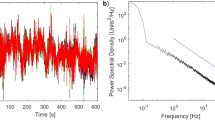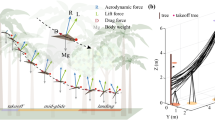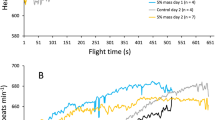Abstract
Flying birds often form flocks, with social1, navigational2 and anti-predator3 implications. Further, flying in a flock can result in aerodynamic benefits, thus reducing power requirements4, as demonstrated by a reduction in heart rate and wingbeat frequency in pelicans flying in a V-formation5. But how general is an aerodynamic power reduction due to group-flight? V-formation flocks are limited to moderately steady flight in relatively large birds, and may represent a special case. What are the aerodynamic consequences of flying in the more usual ‘cluster’6,7 flock? Here we use data from innovative back-mounted Global Positioning System (GPS) and 6-degrees-of-freedom inertial sensors to show that pigeons (1) maintain powered, banked turns like aircraft, imposing dorsal accelerations of up to 2g, effectively doubling body weight and quadrupling induced power requirements; (2) increase flap frequency with increases in all conventional aerodynamic power requirements; and (3) increase flap frequency when flying near, particularly behind, other birds. Therefore, unlike V-formation pelicans, pigeons do not gain an aerodynamic advantage from flying in a flock. Indeed, the increased flap frequency, whether due to direct aerodynamic interactions or requirements for increased stability or control, suggests a considerable energetic cost to flight in a tight cluster flock.
This is a preview of subscription content, access via your institution
Access options
Subscribe to this journal
Receive 51 print issues and online access
$199.00 per year
only $3.90 per issue
Buy this article
- Purchase on Springer Link
- Instant access to full article PDF
Prices may be subject to local taxes which are calculated during checkout



Similar content being viewed by others
References
Nagy, M., Ákos, Z., Biro, D. & Vicsek, T. Hierarchical group dynamics in pigeon flocks. Nature 464, 890–893 (2010)
Dell’Ariccia, G., Dell’Omo, G., Wolfer, D. P. & Lipp, H.-P. Flock flying improves pigeons’ homing: GPS track analysis of individual flyers versus small groups. Anim. Behav. 76, 1165–1172 (2008)
Tinbergen, N. The Study of Instinct (Clarendon Press, 1951)
Lissaman, P. B. S. & Schollenberger, C. A. Formation flight of birds. Science 168, 1003–1005 (1970)
Weimerskirch, H., Martin, J., Clerquin, Y., Alexandre, P. & Jiraskova, S. Energy saving in flight formation. Nature 413, 697–698 (2001)
Higdon, J. J. L. & Corrsin, S. Induced drag of a bird flock. Am. Nat. 112, 727–744 (1978)
Heppner, F. H. Avian flight formations. Bird-Banding 45, 160–169 (1974)
Greene, P. R. & McMahon, T. A. Running in circles. Physiologist 22, S35–S36 (1979)
Usherwood, J. R. & Wilson, A. M. Accounting for elite indoor 200 m sprint results. Biol. Lett. 2, 47–50 (2006)
Usherwood, J. R. & Wilson, A. M. No force limit on greyhound sprint speed. Nature 438, 753–754 (2005)
Pennycuick, C. J. Bird Flight Performance: A Practical Calculation Manual (Oxford Univ. Press, 1989)
Pennycuick, C. J., Klaasen, M., Kvist, A. & Lindström, Å. Wingbeat frequency and the body drag anomaly: wind-tunnel observations on a thrush nightingale (Luscinia luscinia) and a teal (Anas crecca). J. Exp. Biol. 199, 2757–2765 (1996)
Bilo, D., Lauck, A. & Nachtigall, W. in Biona-Report 3 (ed. Nachtigall, W. ) 87–108 (Gustav Fischer, 1984)
Hedrick, T. L., Usherwood, J. R. & Biewener, A. A. Wing inertia and whole-body acceleration: an analysis of instantaneous aerodynamic force production in cockatiels (Nymphicus hollandicus) flying across a range of speeds. J. Exp. Biol. 207, 1689–1702 (2004)
Tobalske, B. W., Hedrick, T. L., Dial, K. P. & Biewener, A. A. Comparative power curves in bird flight. Nature 421, 363–366 (2003)
Schmidt-Wellenburg, C. A., Biebach, H., Daan, S. & Visser, G. H. Energy expenditure and wing beat frequency in relationship to body mass in free flying barn swallows (Hirundo rustica). J. Comp. Physiol. B 177, 327–337 (2007)
Rayner, J. M. V. A vortex theory of animal flight. Part 1. The vortex wake of a hovering animal. J. Fluid Mech. 91, 697–730 (1979)
Ellington, C. P. The aerodynamics of hovering insect flight. V. A vortex theory. Phil. Trans. R. Soc. Lond. B 305, 115–144 (1984)
Spedding, G. R. & McArthur, J. Span efficiencies of wings at low Reynolds numbers. J. Aircr. 47, 120–128 (2010)
Lilienthal, O. Birdflight as the Basis of Aviation (Markowski International, 2001) [transl.].
Usherwood, J. R. Inertia may limit efficiency of slow flapping flight, but mayflies show a strategy for reducing the power requirements of loiter. Bioinspir. Biomim. 4, 015003 (2009)
Pomeroy, H. & Heppner, F. Structure of turning in airborne rock dove (Columba livia) flocks. Auk 109, 256–267 (1992)
Hedrick, T. L., Cheng, B. & Deng, X. Wingbeat time and the scaling of passive rotational damping in flapping flight. Science 324, 252–255 (2009)
Acknowledgements
We would like to thank T. Hubel, H. Chapman, V. Unt and T. Demes for practical assistance, and The Wellcome Trust (J.R.U.), The Royal Society (A.M.W.), BBSRC (K.R.) and EPSRC for funding.
Author information
Authors and Affiliations
Contributions
J.R.U. and A.M.W. conceived and designed the project. J.R.U. analysed the data, and wrote the paper with input from all other authors. M.S. trained the pigeons and helped perform the experiments. J.C.L., K.R. and A.M.W. developed and built the equipment.
Corresponding author
Ethics declarations
Competing interests
The authors declare no competing financial interests.
Supplementary information
Supplementary Information
The file contains Supplementary Methods and Supplementary Tables 1-2. (PDF 263 kb)
Supplementary Movie 1
The movie shows up to 18 pigeons flying in a flock measured with back-mounted GPS and Inertial Measurement Units in June 2010. GPS measurements and logging are activated in response flapping, as identified from the dorsal accelerometer signal. This enables sufficient battery life for continuous field deployment of over two days. The tails show the paths taken in the previous 10 seconds; tail width is proportional to height; tail colours distinguish individual pigeons. Head colours represent flapping frequency above (red) or below (blue) average for each pigeon. Playback rate triple actual rate. (MOV 26519 kb)
Rights and permissions
About this article
Cite this article
Usherwood, J., Stavrou, M., Lowe, J. et al. Flying in a flock comes at a cost in pigeons. Nature 474, 494–497 (2011). https://doi.org/10.1038/nature10164
Received:
Accepted:
Published:
Issue Date:
DOI: https://doi.org/10.1038/nature10164
This article is cited by
-
An equation of state for insect swarms
Scientific Reports (2021)
-
Three-dimensional time-resolved trajectories from laboratory insect swarms
Scientific Data (2019)
-
Costs and benefits of social relationships in the collective motion of bird flocks
Nature Ecology & Evolution (2019)
-
When flocking is costly: reduced cluster-flock density over long-duration flight in pigeons
The Science of Nature (2019)
-
Non-vocal communication as an anti-predator strategy in scaled doves (Columbina squammata)
Journal of Ethology (2019)
Comments
By submitting a comment you agree to abide by our Terms and Community Guidelines. If you find something abusive or that does not comply with our terms or guidelines please flag it as inappropriate.



